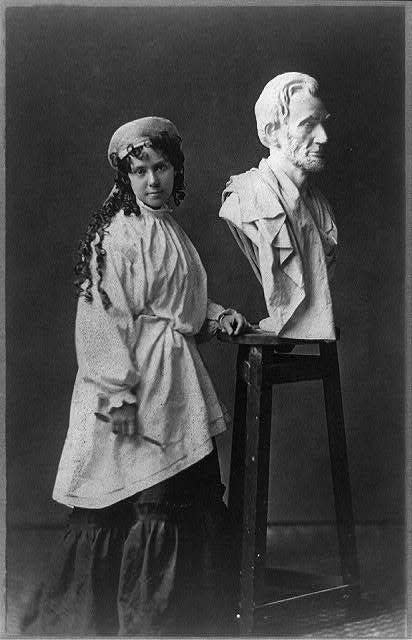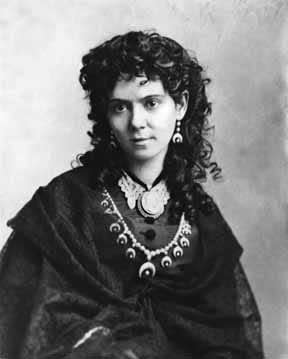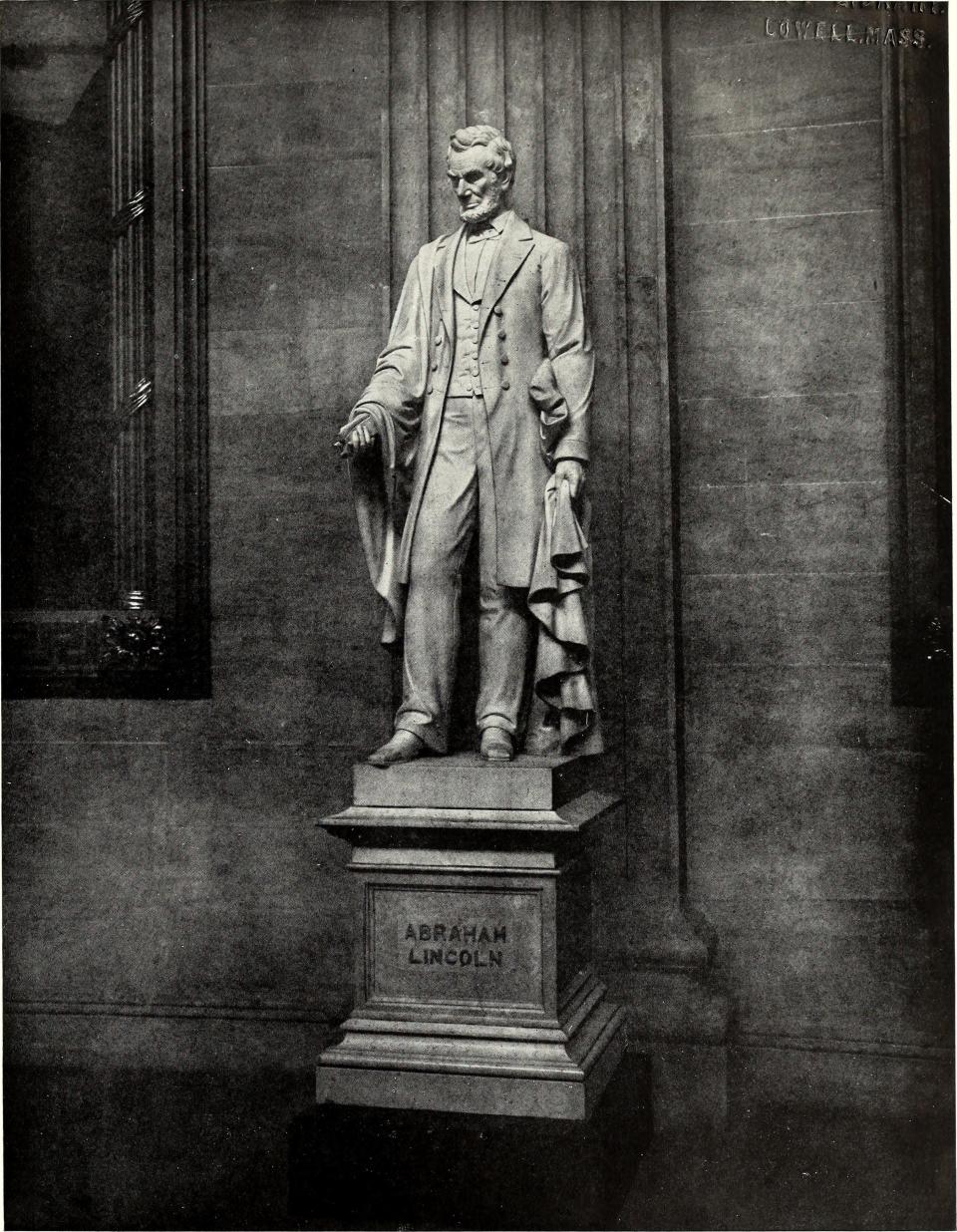The Monday After: Remembering sculptor Vinnie Ream and Abraham Lincoln

- Oops!Something went wrong.Please try again later.
- Oops!Something went wrong.Please try again later.
Sculptor Vinnie Ream of Canton was famous enough to make the "Through A Century" column in The Canton Repository 100 years after she made history.
"100 YEARS AGO – A former Canton girl, Miss Vinnie Ream, was gaining worldwide fame as a sculptress," the column of recollections remembered for Repository readers. "She had just been commissioned to do a statue of President Lincoln for the federal government."
And, she also was interesting enough in history to be turned into a "filler" item – a journalistic term for tidbits once used in newspapers to fill spaces between longer stories.
More:The Monday After: Pueblo captive remembered time as prisoner of North Koreans
"Vinnie Ream was the first woman to receive a federal art commission from the United States government" said the Repository on Dec. 6, 1937. "She executed the statue in the rotunda of the Capitol under this commission."
The sculptor with Stark County ties was only a teenager when she was given the opportunity to memorialize President Abraham Lincoln in the 1860s.
"Abe Lincoln models for Miss Vinnie when she is 18 in 1864," said Tom Haas, a researcher for Wm. McKinley Presidential Library & Museum, who happened upon details of the career of the artist and passed along seeds to grow into a profile of "Miss Vinnie."
"She starts sculpting this sculpture in 1869 at 23 years old. She completed this work by 1871 (and) she receives $15,000 for this commission."
More than 150 years later, the sculpture of one of the nation's most beloved presidents remains displayed in the U.S. Capitol Rotunda.
More:The Monday After: 'Canton Favorite Cook Book' a relic of the past
Remember her time in Canton
Vinnie Ream's connection to Stark County, while it was not as strong as a native's, still rings significant enough to warrant the Repository's occasional coverage of her as a "Canton girl."
"The marriage of Lieutenant R.L. Hoxie to Miss Vinnie Ream took place last evening at Ascension Church," reported a social brief in The Canton Daily Repository on May 29, 1878. "The bride was given away by General Sherman."
Ream was born on Sept. 25, 1847, in Madison, Wis., where her father was a government surveyor. The family moved to Columbia., Missouri, where young Vinnie attended a Christian school.
While she was developing as an artist, Ream worked in studios in Washington and New York City, also studying abroad in Europe.
It was in Europe late in the 1860s that Vinnie Ream met Ida Saxton, later to become Ida Saxton McKinley after marrying a man who would become president, Canton's William McKinley.
Beyond that acquaintance with a well-known of Canton resident, it appears Ream's father for a time operated a store in northern Stark County. It was there that his daughter would labor when she was in Ohio for visits.
In his research, Haas uncovered evidence of trips to Ohio in a newspaper society brief reported late in the 1880s.
"Miss Vinnie Ream, who was visiting for several weeks at Salem," reported a note in a column of items related to Greentown published in the Repository on July 17, 1889, "has returned and is again behind the counter in her father's store."
Ream's passion was not mercantile in nature, and her heart always returned to her art, the study of which was fostered by her family.

Finds patrons in Washington
It was in the 1860s when Ream moved to Washington, and where, with her father in ill health and her family in need of additional income, she worked as a postal clerk in the dead letter office and earned a much-needed $50 a month.
Washington was where, through an introduction by Missouri congressman James Rollins, whom she knew as a family aquaintance, young Ream met Clark Mills, one of the most respected sculptors of the time.
"When Clark Mills met the pretty young lady and learned of her sculpting ambitions, he responded by throwing her a lump of clay," recalled a profile of Ream published in the Columbus Dispatch on Feb. 10, 1974. "'Do a portrait of me,' he said, expecting her to back off with excuses of all kinds. But Vinnie set to work immediately and surprised Mills with a crude, but excellent effort."
This evidence of Ream's "inborn talent" caused Mills to invite the young girl to work as his student-helper.
An introduction by Rollins also enabled Ream to meet and model the president of the United States, Abraham Lincoln, a man she previously had seen as a 14-year-old riding with her family in the back of a carriage. The Lincoln she watched striding along Pennsylvania Avenue that day was a solitary figure, a "man of sorrows."
"I never saw a face with such lines of sadness," she once said.
It was that sorrow that she would remember, and again experience, when she began to model Lincoln at work in his White House office near the end of his life.
More:The Monday After: When Walter Wellman came to Canton
Lincoln stricken with sadness
"Congressman Rollins, with the help of Sen. Orville Browning, made a personal appeal to the President on Vinnie's behalf," said the Dispatch article. "So it was that near the end of the year 1864, Vinnie Ream, along with her tools and a large tub of clay, entered the White House for her first meeting with the President of the United States. For the next five months she kept daily half-hour visits with Lincoln, tirelessly working on her dream."
Another Dispatch article, published in the newspaper on Feb. 10, 1954, noted the sittings took place the last five months of Lincoln's life.
"The Lincoln who revealed himself to Vinnie Ream was not Lincoln the genial storyteller. For the most part, he brooded in silence. ... When he did talk, Vinnie recalled later, it was usually about the greatest sorrow of his life, the death of his son Willie. For some reason, the young girl with dark hair curling around her oval face, her eyes pensive and inquiring, reminded Lincoln of his lost son. Often he wept as he talked."
Later, Ream recalled in her diary Lincoln's mood during the sittings.
"I remember him especially in two attitudes. The first was with his great form slouched down into a chair at his desk, his head bowed upon his chest, deeply thoughtful. ... The second was at the window watching for Willie, for he had always watched the boy playing at that window. Sometimes great tears rolled down his cheeks."
Ream's last modeling session with Lincoln was April 14, 1865, the day the president was shot at Ford's Theatre in Washington, D.C. He died the following day, and Ream was left with her sketches, clay model and a marble bust of the president that resulted from the sittings to help her complete the more famous Lincoln project that was to come.

Seeks Lincoln statue commission
When a competition for a statue of Lincoln was proposed by the U.S. Congress following the passing of Lincoln, it piqued Ream's interest. Hadn't she already proven herself adept at portraying the president?
Although she was accused of "unladylike lobbying" and there was much public debate over whether such a young woman artist was skilled or experienced enough to create such a visual addition to the Capitol Rotunda, Ream's request for the commission was approved in the House of Representatives on July 26, 1866, and went to the Senate the next day.
"That evening, Vinnie received a message to meet (supporting U.S. House Representative) Thaddeus Stevens in the Senate Gallery," recalled an excerpt from Glenn Sherwood's book – "A Labor of Love: The Life and Art of Vinnie Ream" – posted at the website vinnieream.com. "She was nervous about going to the Senate session alone and asked General William T. Sherman to accompany her to the proceedings.
(Information has been corrected to fix an error. See correction below 3 p.m. 2/27/23)
"Vinnie walked in with Sherman and looking toward them, a number of Senators began applauding and waving their handkerchiefs. ‘Look, they're giving an ovation to General Sherman,’ Vinnie said to Stevens. 'No Vinnie,' he replied smiling, 'They are giving you an ovation. Your Lincoln has been accepted.'"
Ream's statue not her only artwork
During her career in sculpting, interrupted for years by her marriage to Hoxie, she did many more pieces of artwork than her Lincoln projects. A large sculpture of Admiral David Farragut ("Damn the torpedoes; full speed ahead!") in Washington was among them.
"Vinnie Ream's colossal statue of Admiral Farragut, cast in bronze from the old propeller of Farragut's flagship, The Hartford, was on Wednesday placed in position in Farragut Square," a brief article in The Canton Daily Repository said on Sept. 30, 1880.
Still, it was her work on the Lincoln statue that earned her fame.
The Lincoln statue was unveiled to the public in January 1871.
"It was a dreary January evening in Washington, D.C. Yet a multitude of people gathered on the steps of the United States Capitol. They came for a chance to gain admission to the Rotunda and be a part of the history being created inside," recalled a documentary, "Vinnie Ream: Lincoln's Young Sculptor," which is based on Sherwood's book.
"In a moment etched in time, applause broke out, filling the Rotunda and washing over the statue and its creator, the young woman Vinnie Ream."
Ream's statue of Lincoln, which "depicts him with a serious, contemplative expression," notes the government's "Architect of the Capitol" website, has remained in the Capitol Rotunda for more than 150 years.
When Ream died on Nov, 20, 1914, she was buried, with her husband, in Arlington National Cemetery, their graves marked by Ream's statue, "Sappho."
It is, of course, the same cemetery in which the slain President John F. Kennedy was buried after he, too, was assassinated in 1963. When Kennedy's casket was displayed in the Capitol Rotunda for mourners to pass by one last time, it was set – appropriately, some say – beneath Ream's Lincoln statue, an online historical account took note.
"Lincoln's statue seems to be sadly looking down on the casket of the martyred John F. Kennedy."
Reach Gary at gary.brown.rep@gmail.com. On Twitter: @gbrownREP.
CORRECTION: Thaddeus Stevens, R-Pa., served in the U.S. House of Representatives. His political office was incorrect when this article first published.
This article originally appeared on The Repository: The Monday After: Remembering sculptor Vinnie Ream and Abraham Lincoln

